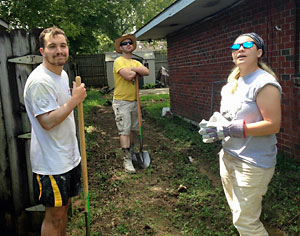Hope and Clarity
October 3rd, 2017 | SIT Graduate Institute

by Chris Bailey
Before I came to SIT, all I had was a strong desire to find a way to help others and work on building a peaceful world. After the on-campus portion of my degree, I found direction, hope, and clarity on the various ways I could use my passions.
I am currently enrolled in the Conflict Transformation master’s degree program at SIT, and I’m doing the off-campus practicum portion of my degree in the field of disaster relief. The SIT graduate program is broken up into two portions – the on-campus, 10-month intensive course work, and the off-campus practicum stage. For the first 10 months you are located in Brattleboro, Vermont, on campus and taking classes from professors who are still actively practicing in the fields that they are teaching.
The professors’ in-depth insight into their fields has been inspiring and impactful in understanding how to affect change. I was able to study theory, but also examine real-life examples of how peacebuilding can be used during even the darkest times. I have also worked with and learned from other students who have dedicated their lives to helping others. I have made friends and colleagues that I will cherish and, no doubt, contact for advice throughout my career.
The off-campus portion of my degree is the six-month to one year internship/practicum. During this portion, you find a job or internship that allows you to practice the theory that you learned in the class room. At your practicum site, you will work with a supervisor and a professor to help you process your experience and learning. The two work as personal, professional developers for your career. During this portion, you write papers on your experiences, growth, and the theory used in the field.
For my practicum, I came back home to Louisiana help with a problem that has been sweeping many coastal cities. I work at the Saint Bernard Project (SBP) in Baton Rouge, Louisiana. SBP is a disaster relief non-profit that began after Hurricane Katrina devastated New Orleans in 2006. The founders and organization found that the traditional method of disaster relief was highly inefficient and slow. They began SBP to “shrink the time between disaster and recovery.” They now have a presence in 11 states and even more cities. They are deploying to Texas in at least two cities to help rebuild after the recent disaster caused by Hurricane Harvey.
In August of 2016, Baton Rouge and surrounding cities were hit with a once-in-a-century flood, due to a historic rain fall. My city was devastated. People were left homeless, without flood insurance, and hopeless. Though the city rallied together to help friends, family, and strangers with their houses, many were still in need. SBP rose to the occasion, and set up an office near the affected areas.
I work as a site supervisor for SBP: South Louisiana, and every day I help to rebuild the houses that were affected by flooding. I am in charge of training and building with the volunteers that come out to help those affected. The work is difficult, but extremely rewarding and worthwhile. I get to talk to homeowners, hear their stories, and help them get back into their houses. Many of those we help are elderly and had lived in their houses for more than 30 years. SBP has allowed them to move forward in their lives and heal from the trauma that the flooding caused.
I believe there are many things in this world that we can do to help others. I have always had the passion to help others, but SIT has helped me develop skills and direction, and given me assistance in making a positive impact in my community. I constantly use the skills I learned at SIT. SIT’s focus on team work and communication has allowed me to be a strong member of the SBP team and an active member in helping those in need.
